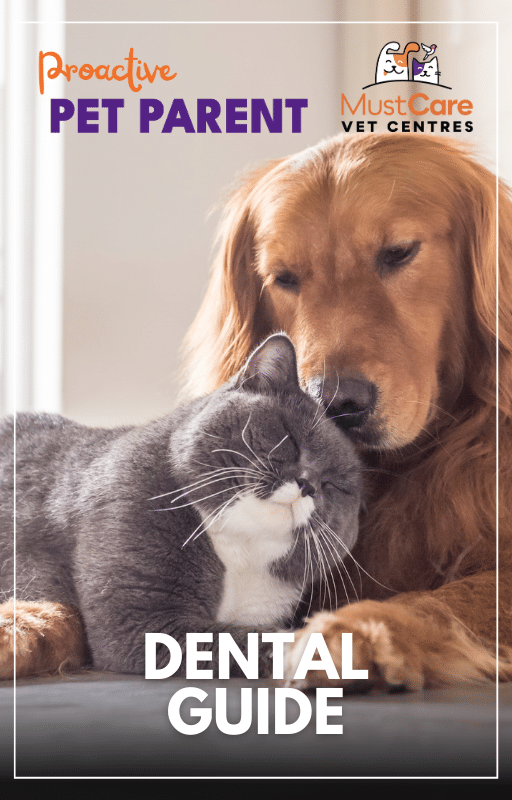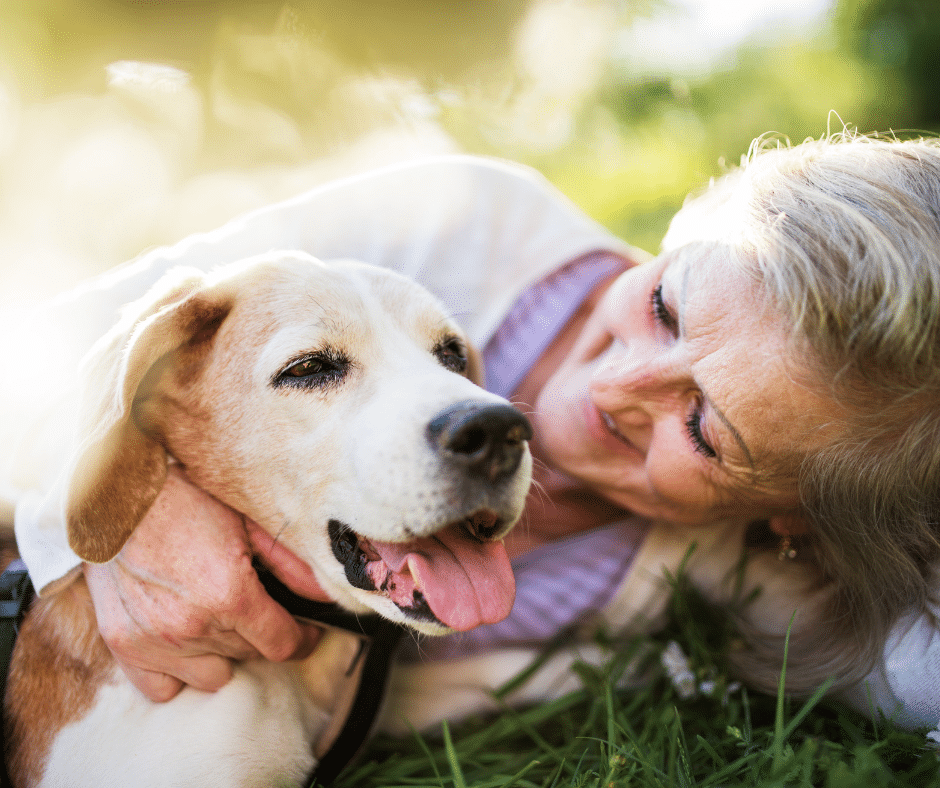Share This Blog With Other Pet Parents!
Senior Pet Heat Safety: Essential Summer Tips for Dogs & Cats
Heat safety for older pets becomes paramount during the heat of summer in Queensland. Just as the needs of senior humans change, so do those of our senior pets, making summer a season of extra care and vigilance. In this article, we delve into vital summer health tips for ageing dogs and cats, focusing on practical strategies to keep them cool and comfortable.
Whether it’s adapting their exercise routine to avoid the midday heat or tweaking their diet for optimal hydration, we’re here to guide you through ensuring your furry family member enjoys the summer safely.
What you’ll learn from this blog:

For all you need to know, download our
FREE Dental Guide
This blog is part of our Proactive Pet Parent series! This is just the beginning… To see more blogs, click here! Better yet, sign-up to our newsletter to receive these directly to your inbox each month.
Sign-up To The Proactive Pet Parent Newsletter
The rising temperatures, while great for beach outings and barbecues, can pose a significant threat for our older pets. These faithful friends, who have been our constant companions through various life stages, now face a new set of challenges as they navigate through their senior years. The heat can be more than just uncomfortable for them; it can be a serious health hazard. Their advanced age renders them more susceptible to the rigours of extreme weather, making it crucial for us as responsible pet owners to pay extra attention to their needs during these warmer months.
Understanding the Risks
In the scorching summer months, the risks to our ageing pets escalate significantly, with heatstroke and dehydration being the most immediate threats. These conditions can escalate into life-threatening emergencies, particularly for senior dogs and cats. The reasons for their heightened vulnerability are multifaceted. As pets age, their ability to regulate body temperature diminishes, and they might struggle to stay cool. Older pets often have chronic health issues, like heart disease or obesity, which can exacerbate the effects of high temperatures. Additionally, their diminished thirst response means they may not drink enough water, leading to dehydration.
Heatstroke in pets is a critical condition marked by an elevated body temperature, often exceeding 40°C. It can cause serious complications such as organ failure, and in severe cases, it can be fatal. Symptoms of heatstroke include excessive panting, drooling, lethargy, and unresponsiveness. Dehydration, on the other hand, occurs when a pet loses more fluid than they consume. This can lead to dry gums, sunken eyes, and in extreme cases, kidney failure. It’s imperative to understand that these conditions develop quickly and require immediate attention.
In contrast to their younger counterparts, senior pets may not show obvious signs of distress until they are in a critical state. They may not pant as loudly or move to cooler areas, making it crucial for pet owners to proactively monitor their environment and behaviour. Understanding these risks is the first step in safeguarding our ageing pets from the harsh realities of summer.
Signs of Heat-Related Distress
Recognising the signs of heat-related distress in ageing pets is crucial for timely intervention and prevention of serious health consequences. Heatstroke and dehydration, while severe, often begin with subtle indicators that can be easy to overlook, especially in older animals. One of the most common symptoms is excessive panting. Unlike normal panting, which is a regular cooling mechanism, this panting is intense and does not stop even when the pet rests in a cool place. Lethargy or uncharacteristic tiredness is another red flag. An active pet suddenly becoming sluggish or uninterested in activities they usually enjoy is a cause for concern.
Other signs include an increased heart rate, drooling more than usual, and in some cases, fainting or collapsing. The pet’s gums can also give vital clues; they may turn bright red or pale, indicating heatstroke or dehydration. Owners might also notice a decreased urine output or very dark urine, signalling inadequate hydration.
It’s important to remember that these symptoms can escalate rapidly. If any of these signs are observed, it’s imperative to take immediate action. This might involve moving the pet to a cooler area, providing fresh water, and contacting a veterinarian as soon as possible. In cases of heatstroke, prompt veterinary attention is not just beneficial; it can be life-saving.
Creating a Cool Environment
Ensuring a cool and comfortable environment for ageing pets during summer is a vital aspect of their care. As temperatures rise, our homes can become uncomfortably hot, particularly for senior pets who struggle with heat regulation. One effective measure is maintaining a cool indoor temperature through air conditioning or fans. It’s essential to keep the air circulating, as stagnant, hot air can exacerbate heat-related issues. If air conditioning isn’t an option, positioning fans strategically to create a cross breeze can significantly reduce indoor heat.
Shade is another crucial factor. Make sure there are plenty of shaded areas accessible to your pet, both indoors and outdoors. These spots provide a much-needed refuge from direct sunlight, which can be particularly harmful to older pets. Also, consider the flooring; tile or hardwood floors offer a cooler surface for pets to lie on compared to carpets or rugs.
Additionally, you can create a designated cool spot for your pet using cooling mats or damp towels that they can lie on. Elevating their bed to allow for air circulation underneath can also help in keeping them cool. The cooler the environment, the easier it is for your senior pet to regulate their body temperature.
Hydration is also a key component of a cool environment. Ensure that fresh, cool water is available at all times, and consider placing multiple water bowls around the house for easy access. In extreme heat, adding ice cubes to the water can be a welcome relief for your pet.
Lastly, be mindful of the indoor environment when you’re not at home. If you’re leaving your pet alone, ensure that the house remains cool and ventilated, and that your pet has access to all their cool resting spots and water.
Diet and Hydration
In terms of diet, the summer heat may affect your pet’s appetite. It’s not uncommon for pets to eat less when it’s hot, so it’s important to ensure that what they do eat is nutrient-rich and appropriate for their age and health condition. Consult with your veterinarian to adjust your pet’s diet if necessary, keeping in mind their specific nutritional needs. Some pets may benefit from wet food during the summer months, as it can be an additional source of hydration.
Another aspect to consider is the timing of meals. Feeding your pet during the cooler parts of the day, such as early morning or evening, can encourage them to eat if they are reluctant during the hotter periods. Also, be cautious with treats and avoid those that might be too heavy or rich for a summer diet.
Diet and hydration play a vital role in regulating your pet’s body temperature and overall well-being. Regular monitoring and adjustments, as needed, can help your senior pet stay comfortable and healthy throughout the summer.
Safe Exercise and Activity
In the summer heat, exercising ageing pets requires a balanced approach to ensure their safety and well-being. The timing of outdoor activities is pivotal. Early morning or late evening, when the temperatures are cooler, are the best times for walks. These periods offer a more temperate environment, reducing the risk of heatstroke and dehydration. It’s also important to choose the right type of exercise. For senior pets, low-impact activities like gentle walks or brief, leisurely play sessions can provide the necessary exercise without overexertion.
Be mindful of the surfaces you walk on. Hot pavement or sand can not only be uncomfortable but also harmful, potentially causing burns to sensitive paw pads. Test these areas with your hand – hold your hand to the surface for 5 seconds and if it’s too hot for your hand, it’s too hot for your dog’s paws. Grass or shaded paths are preferable. Always carry water during walks to keep your pet hydrated, and consider a portable water dish for convenience.
Understanding your pet’s limits is crucial. Watch for signs of fatigue or overheating, such as heavy panting or slowing down, and be ready to cut the exercise short if needed. Don’t push them to go further or faster than they’re comfortable with.
For pets that struggle with mobility or are particularly susceptible to heat, indoor activities can be a great alternative. Interactive toys, treat puzzles, or simple games like hide and seek with toys can keep them mentally stimulated and physically active without the risk of heat exposure.
Adapting to your ageing pet’s needs during the summer is key. By carefully considering the timing, type, and duration of activities, you can help your senior pet enjoy the summer months safely and comfortably.
Regular Check-Ups and Preventative Care
Regular veterinary check-ups are a cornerstone of preventative care for senior pets, especially in the summer months. As pets age, they become more prone to health issues that could be exacerbated by the heat. Proactive health management, including regular vet visits, can help catch and address these issues early. During these check-ups, vets can assess your pet’s overall health, monitor ongoing conditions, and advise on any specific summer care needs.
Preventive measures are particularly vital during this time. Discuss with your veterinarian about the best strategies to keep your pet healthy in the heat. This could include dietary adjustments, hydration tips, or even changes to medication if needed. Your vet can also provide guidance on managing any existing conditions in the warmer weather, ensuring your pet’s comfort and safety.
Knowing when to consult with a veterinarian is equally important. If you notice any unusual behaviour or signs of distress in your pet, it’s crucial to seek professional advice. This could range from subtle changes in appetite or activity levels to more overt signs like excessive panting or lethargy. Early intervention can prevent minor issues from turning into major health concerns.
In addition to regular check-ups, keep an updated record of your pet’s medical history and any current medications. This information is invaluable for vets to provide the best possible care.
As we wrap up our discussion on caring for ageing pets during the summer, it’s clear that the warmer months require special attention to ensure the safety and comfort of our senior companions. The key to managing the heat for these pets lies in vigilance and proactive care.
We encourage you to implement these tips and make this summer a safe and enjoyable time for your ageing pets. Your efforts can significantly enhance their quality of life and help them navigate the challenges of the season with ease.

